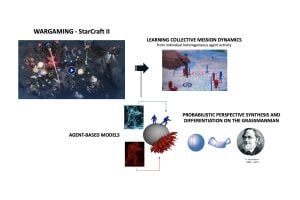
Assistant research professor, Dimitris Giovanis, has been awarded a competitive research grant by the Defense Advanced Research Projects Agency (DARPA) as part of the COMPASS initiative—Critical Orientation of Mathematics to Produce Advancements in Science and Security. The program, which focuses on creating robust mathematical tools for national defense, aims to enhance military commanders’ situational awareness and reduce ambiguity in complex operational environments.
“We’re working to produce a new mathematical model that reliably constructs a complete picture of multiple data points and observations from varying spatial perspectives—the challenge is in synthesizing all of that information to form a complete, comprehensive picture to inform decision-making,” said Giovanis, the study’s principal investigator.
The COMPASS initiative recognizes that modern military operations rely on unifying information from multiple domains—air, land, maritime, space, and cyberspace. Each domain presents unique challenges, requiring mathematical approaches that can process messy, overlapping, and incomplete data.
“Across defense and science, we often study objects or situations using many sensors, instruments, and viewpoints,” said Giovanis. “But not every difference between measurements reflects a real change in the world—some variations just come from the quirks of the sensors themselves. This project will tease apart the layers to give a clear picture of what’s actually happening in simulated combat environments. Our goal is to enable commanders and analysts to differentiate between common and unique features of adversarial behavior, reduce uncertainty, and generate clearer situational awareness in complex scenarios,” he said.
Giovanis’ proposed methodology combines advanced tools from differential geometry, with machine learning techniques, such as manifold learning, generative learning, and probabilistic modeling. This approach allows for the differentiation and subsequent integration of sensor data and battlefield observations.
“By representing each dataset as points on a proper manifold, we can geometrically disentangle what’s common and what’s unique,” Giovanis said. “Then, using probabilistic models, we’ll characterize how confident we are in these separations. Finally, generative modeling lets us simulate or reconstruct accurate representations, even under uncertainty.”
If successful, this approach could revolutionize how intelligence and military systems interpret data.
Potential applications could include isolating deceptive objects in distributed surveillance, aligning virtual reality systems with operator perspectives, and assisting electronic warfare teams in separating authentic signals from spoofed signals.
“Situational awareness is about more than just aggregating data—it’s about understanding the data, even in the face of ambiguity,” said Giovanis. “This method could be the foundation for safer decision-making, better strategy development, and more adaptive defense systems.”